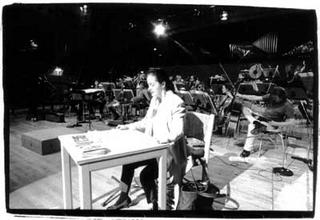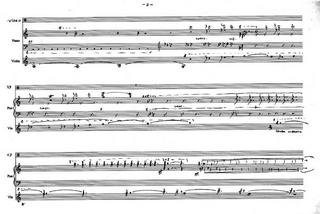| Record companies, artists and publicists are invited to submit CDs to be considered for review. Send to: Jerry Bowles, Editor, Sequenza 21, 340 W. 57th Street, 12B, New York, NY 10019 |
Latest Posts
Two from OmniTone
solo cello music of john cage
Kinga Prada, Kingám: New Swedish Flute Music
Three Reviews.
A smattering of the more recent and the old...
New Music From Eastern Europe
Xenakis
Musical Miscellany
Mostly Naxos
Antheil, Lauridsen, Martinu et al
Record companies, artists and publicists are invited to submit CDs to be considered for our Editor's Pick's of the month. Send to: Jerry Bowles, Editor, Sequenza 21, 340 W. 57th Street, 12B, New York, NY 10019



|
Archives
Saturday, December 18, 2004
Saturday, December 25, 2004
Friday, December 31, 2004
Wednesday, January 05, 2005
Monday, January 10, 2005
Thursday, January 13, 2005
Thursday, January 20, 2005
Sunday, January 23, 2005
Monday, January 24, 2005
Saturday, January 29, 2005
Wednesday, February 02, 2005
Thursday, February 03, 2005
Monday, February 07, 2005
Tuesday, February 08, 2005
Friday, February 11, 2005
Monday, February 14, 2005
Wednesday, February 16, 2005
Tuesday, February 22, 2005
Monday, February 28, 2005
Sunday, March 06, 2005
Monday, March 07, 2005
Wednesday, March 09, 2005
Sunday, March 13, 2005
Friday, March 18, 2005
Monday, March 28, 2005
Saturday, April 02, 2005
Monday, April 11, 2005
Sunday, April 17, 2005
Tuesday, April 19, 2005
Monday, April 25, 2005
Monday, May 02, 2005
Monday, May 09, 2005
Tuesday, May 17, 2005
Tuesday, May 31, 2005
Monday, June 06, 2005
Thursday, June 16, 2005
Sunday, June 19, 2005
Sunday, July 10, 2005
Wednesday, July 13, 2005
Sunday, July 24, 2005
Friday, July 29, 2005
Monday, August 08, 2005
Monday, August 22, 2005
Wednesday, August 24, 2005
Friday, September 16, 2005
Sunday, September 25, 2005
Tuesday, October 04, 2005
Tuesday, October 18, 2005
Monday, October 24, 2005
Tuesday, November 01, 2005
Monday, November 07, 2005
Saturday, November 12, 2005
Wednesday, November 16, 2005
Tuesday, November 29, 2005
Friday, December 16, 2005
Monday, January 09, 2006
Thursday, January 12, 2006
Thursday, January 19, 2006
Tuesday, January 24, 2006
Thursday, February 02, 2006
Monday, February 13, 2006
Wednesday, February 15, 2006
Wednesday, March 01, 2006
Sunday, March 19, 2006
Sunday, March 26, 2006
Friday, March 31, 2006
Sunday, April 09, 2006
Monday, April 10, 2006
Thursday, April 20, 2006
Friday, April 21, 2006
Thursday, May 11, 2006
Thursday, May 18, 2006
Saturday, May 20, 2006
Friday, June 02, 2006
Tuesday, June 06, 2006
Friday, June 16, 2006
Monday, June 19, 2006
Sunday, June 25, 2006
Monday, June 26, 2006
Monday, July 10, 2006
Thursday, July 13, 2006
Thursday, July 20, 2006
Friday, July 21, 2006
Sunday, July 23, 2006
Thursday, August 03, 2006
Wednesday, August 09, 2006

|
|
Monday, August 22, 2005
an overview of the music of maria de alvear

Maria de Alvear is a composer of Spanish/German descent who currently resides in Germany. There is an abundance of information about her on the Web, including the Wikipedia and the composer's own site, so I would like to provide more of an overview of her music. It is fortunate that a great deal of her music is available on CD, including the composer's World Edition label.
While de Alvear's music has been compared with the music of Feldman, there are many differences. Maria de Alvear's music is frequently quiet, influenced by art (the composer is also an artist and sculptor), often long and focused (I hate to use the term repetitive, since it implies something her music is not). However, her music is deeply spiritual in a way that Feldman's is not, and often combines instrumentalists with a vocalist (de Alvear herself in several recordings) who intones words in a fashion similar to sprechstimme. Rather than repeating small fragments, de Alvear is more concerned with focusing on chords that gradually grow louder and more forceful. Single tones are also important to her, as they are to Young and Cage, but are treated very differently. Her notation is also often free, with tempo and durations to be interpreted by the performer. Very importantly, the music of Maria de Alvear is inspired by indigenous cultures, including those of Native Americans. Finally, de Alvear wants to break down cultural and social taboos, including those surrounding sexual issues.
The first work of Maria de Alvear that I became familiar with is her piano composition En Amor Duro. It is a work lasting around 50 minutes and remains my favorite work of hers. There are moments that are beyond beautiful, particularly a section near the end that repeats a chordal structure many times very quietly. The piece is often near silent or very loud, and is notated in a fashion that invites, if not demands, careful interpretation. According to the composer, the work is about pain, but I find it more passionate than dolorous.
Now onto the more controversial works. As mentioned, de Alvear desires to destroy taboos, and this is evident in her works Sexo and Vagina. Sexo is described as a ceremony for acting vocalist, violin and orchestra, while Vagina is a ceremony for voice and chamber ensemble. In the composer's words, "SEXO...is a passionate examination of all the taboos and all the advantages and disadvantages involved with sexuality." The CD liner notes makes reference to all forms of vulvae, including the vulva sacra, vulva erecta erecta, etc., none of which they ever taught me about during my gynecology residency. Moving between several different languages, the vocalist in Vagina presents an impassioned description of an experience the composer had with the Iroquois in North America that has been described as "a pure merger with Spirit."
Other works that are similarly infused with spirituality include the piano work Llena, Libertad, and Baum for voice and percussion ensemble.
Two works that I am particularly captivated by are World and Thinking. World has been described as a two-piano concerto, but I'm not sure that really does it justice, nor is it entirely accurate. World certainly is scored for two pianos (tuned a quarter tone apart, much like the pianos in Ives' Three Quarter Tone Pieces) along with orchestra, but one piano is particularly dominant. Again, many repetitive chords present themselves, with an incredible section in the last five minutes of the piece that builds to a climax. The contrast between the two pianos is particularly noteworthy. Thinking is for violin and piano in conjunction with a video. With very rare exceptions, the violin never plays more than one note at a time. However, there are sections where the violin plays rapidly in its extreme high register, and this is clearly done for the music's sake, not effect. 
One important thing about de Alvear's music is that it is not written to any system, architecture, or other external constraint. She just writes it, based on the music itself. The purity of her approach, and the intense discipline it requires from performers such as Hildegard Kleeb, Ensemble Modern and Marc Sabat, is nothing short of extraordinary. I should also add that her music is not always "easy" to listen to. There is a rawness and purity of spirit to it that compels me to listen to those works that I might not have entirely warmed up to, and eventually her music wins me over. There is really nothing quite like it. While I suppose she owes something to her teacher Mauricio Kagel, her music is her own. Its theatricality, passion, intensity, extended lengths, extremes of dynamics, unconventional notation and other attributes place it in a unique category. A short review such as this one cannot due this music justice---the only way to understand the music of de Alvear is to experience it for itself. This is music, indeed, that begs to be experienced, not just listened to.
posted by David Toub
8:33 PM
|
|




